Back in 2014, I received a LinkedIn message from the CEO of Better Business Bureau Northwest + Pacific who was interested in getting marketing help but explicitly stated he probably couldn’t afford to hire me in-house. Instead, we decided to work on the basis that I’d bring him on as a client for my marketing firm and help with two specific initiatives: grow awareness and generate qualified leads.
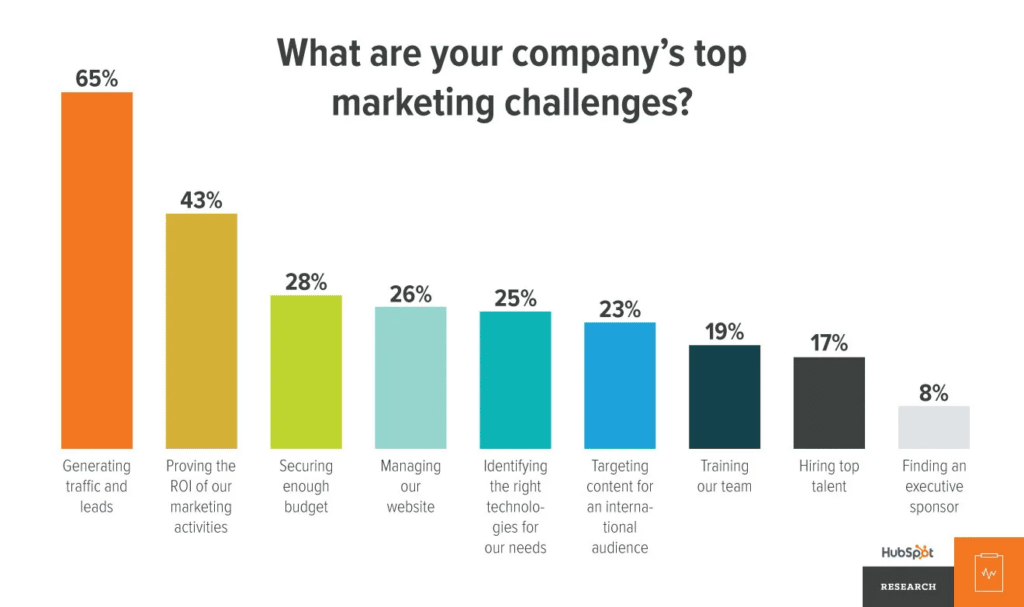
Naturally, ensuring that the martech stack they had in place — as well as specifics on how tools were set up to foster both initiatives — was something that needed to be done as well. To make things easy, we started off as more of a ‘pilot’ type working relationship, such that my team would help only with PPC as a starting point for three months.
In those short months, we were able to prove ourselves not only from an executional stance but also strategic — providing valuable and feasible ideas, growing their digital presence, and generating qualified leads to their sales team. We were seeing over 100-200% increase in site traffic to the application page and completed applications. If we were to account that growth with the LTV for each AB, we saw a 5x ROI.
Pretty nuts, right?
We thought so too. There was a ton of room for growth and back in 2014, the digital marketing landscape itself was changing so quickly it was hard to keep up, especially if you weren’t a subject matter expert. The CEO from BBBNWP and I also ran a webinar together which you can check out here:
Since our results were proving to provide a great ROI for BBBNWP, we went on to work with them for the next 6 years and expanded our scope of work into all things digital (e.g. SEO/SEM, third party advertising, email marketing, social media, content marketing, etc.)
With all of this in mind, what exactly did I take away?
Before I decided to write this blog post, I wanted to make sure that whatever I wrote was honest, transparent, and provided value to BBBs. No, I’m not being paid to write this if you’re wondering! In the six years I had the pleasure of working with BBBNWP, my team and I became such an integral part of their marketing team and I believe there’s a ton of great nuggets other BBBs can learn from, then implement for themselves too.
Let’s get started…
1. PPC and Social Ads Are the Best Advertising Channels
All BBBs have a database of leads that they can fish for, but acquiring new leads was also important. As such, we found that PPC and social ads worked best in driving awareness (~3.8M+ impressions), visit to lead % exceeded 70%, and the ability to target personas by region was instrumental to our success.
Not a huge surprise specifically, because of the following reasons:
- 74% of brands say PPC is a huge driver for their business.
- 65% of B2B companies have acquired customers through LinkedIn ads.
- 79% of marketers say PPC is hugely beneficial for their business.
- For every $1 spent on Google Ads, businesses earn an average revenue of $2.
- 75% of people say paid ads make it easier to find the information they are searching for.
Let’s dive deeper into each tactic so that you have actionable insights to try for yourself too.
Focus on PPC on Google
Something to be cautious about is that PPC can quickly go through your set budget and even waste your dollars if you don’t keep an eye on it to ensure that you’re bidding on the right keywords, writing great ad copy that entices clicks, and have good landing pages that will actually engage and convert.
I get it, application pages themselves are pretty ugly and difficult to truly convert people, and that’s why BBBs turn to outside agencies to help build out targeted landing pages. I completely agree with this approach, but a delicate balance and constant testing between the application page as well as the landing pages will be helpful.
Additionally, make sure you do the following:
- A/B test as much as you can from headlines, CTAs (call-to-action), button colors, etc.
- Stop the keywords that are underperforming and costing you too much.
- Implement geographical targeting.
- Implement similar audience campaigns.
- Implement placements and topics.
- Run retargeting ads — but make sure that they are relevant based on pages people visited. Being too broad won’t yield any clicks or conversions (i.e. someone filling out a form).
- Look at the type of keyword targeting that’s working the best. Right off the bat, broad targeting isn’t going to do you any good.
- Always bid on your brand name.
- Optimize your ads weekly, but check-in at least 1-2 times a day. The biggest problem we saw with BBBs in general is that since they don’t have the expertise in-house they tend to let their PPC campaigns sit in cruise control.

Focus on LinkedIn and Facebook Ads
LinkedIn ads have come a long way since the beginning of their launch. It’s much easier for targeting now and even more effective, especially in the B2B space. As for Facebook ads, the sophistication of targeting is insanely awesome and any BBB that isn’t taking advantage of this to drive leads, as well as win new customers, should change that ASAP.
In fact, LinkedIn is the second most popular platform of B2B marketers, followed by Facebook, and LinkedIn lead conversion rates are 3X higher than other major ad platforms, including Google Ads. With that in mind, here are key considerations to execute with LinkedIn Ads:
- Target by persona — this means you know exactly who your target audience is narrowed down by their title, role, seniority level, and geographical location. This will help ensure that you’re generating interest in the regions you actually cover.
- Lead forms. This is a fairly new thing and what’s great about it is that you don’t take anyone off LinkedIn — a form populates with all of their information already and is sent directly to you. This means if your hungry salesforce is waiting for qualified leads to close as ABs, then they’ll love this tactic.
- Focus on content and sponsor it.
- Implement lookalike audiences.
- Just as you would A/B test and optimize with Google Ads, you need to take on the same approach with LinkedIn too.
Here are my recommendations for Facebook:
- Do a healthy mix of direct application, content downloads, and lead gen forms.
- Lookalike audience is going to be helpful, so use that.
- Implement custom audiences.
- Implement core audiences.
- Run retargeting relevant to pages visited as you would with Google Ads.
- Refresh your ads 2x quarterly.
- Refresh your ad copy and optimize weekly
- A/B test always!

2. Execute Email Marketing Strategically
Create a killer email marketing strategy that is going to foster your overall goals. In this case, email will help you do the following three things:
- Keep the lines of communication open with ABs
- Nurture non-ABs into becoming ABs
- Educate consumers on the latest scams, trends, etc.
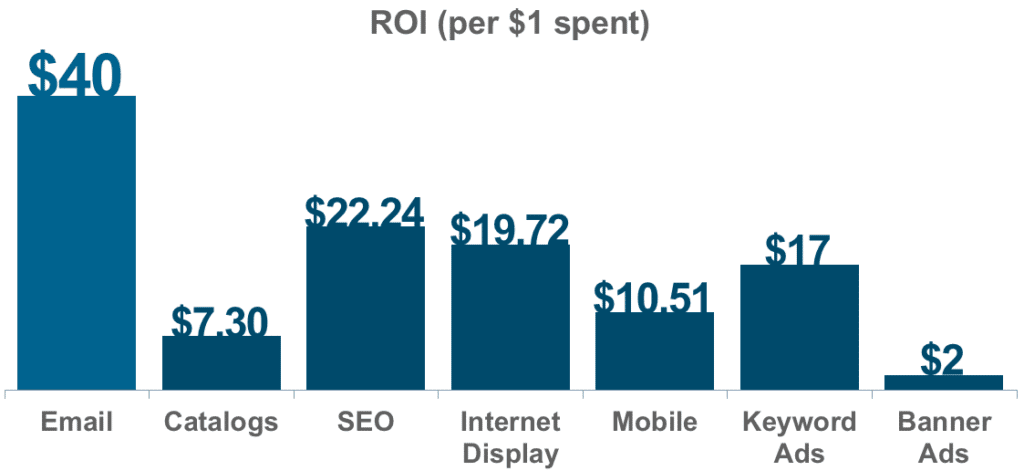
Here’s where I see a lot of BBBs just trying to send out newsletters or emails in general without knowing the best practices to yield strong performance. Email is and can be one of the biggest drivers behind revenue generation, and the biggest hurdle for many BBBs is executing it the right way to make that happen.
For BBBNWP, we made sure that we were writing unique content that spoke to the challenges small and local business owners were facing. That way, the content was broad enough to reach our target audiences without just being partial to a few of the top-performing TOBs.
So what exactly did we do with email marketing that worked?
- Segmentation plays a large role based on TOBs, interest level, and location.
- Personalization by attribution and source — meaning how did the recipients you’re emailing first get in touch, what are they most interested in, and why?
- Automation and workflows based on behavior. For example, someone who opens an email and clicks through is sent down a different workflow than someone who doesn’t even open the email.
- Lead scoring so that you can attach specific data points to what leads as well as ABs are doing when they receive your emails. If they aren’t doing anything, you should have specific thresholds and degradation in place so that you know ‘how’ to reach out to these people.
- A/B test subject lines, copy, and CTAs.
- Attached UTM codes to every single hyperlink and CTA so we knew exactly where email clicks were coming from.
Here’s a high-level example of some of our initial ideation and planning:
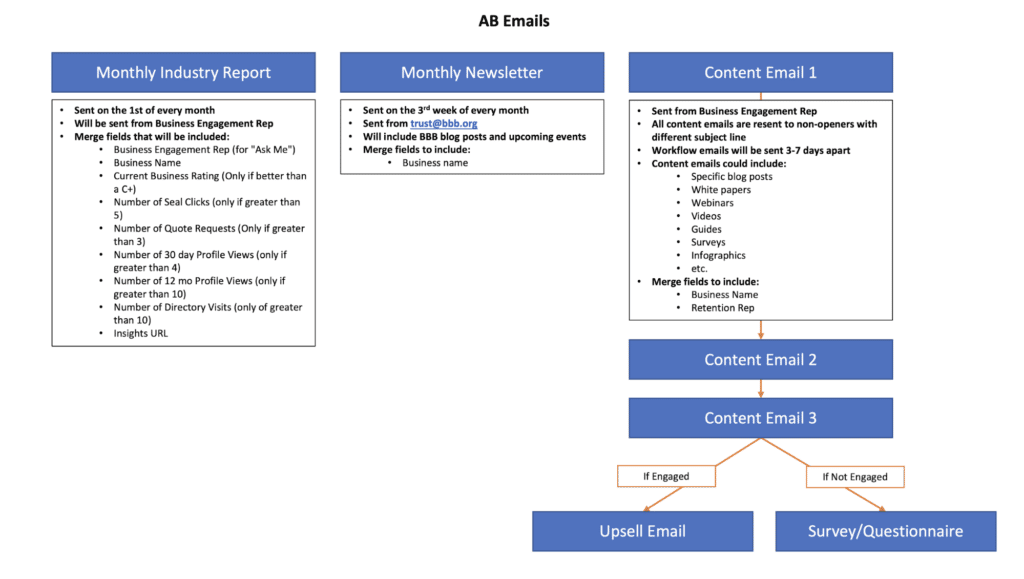

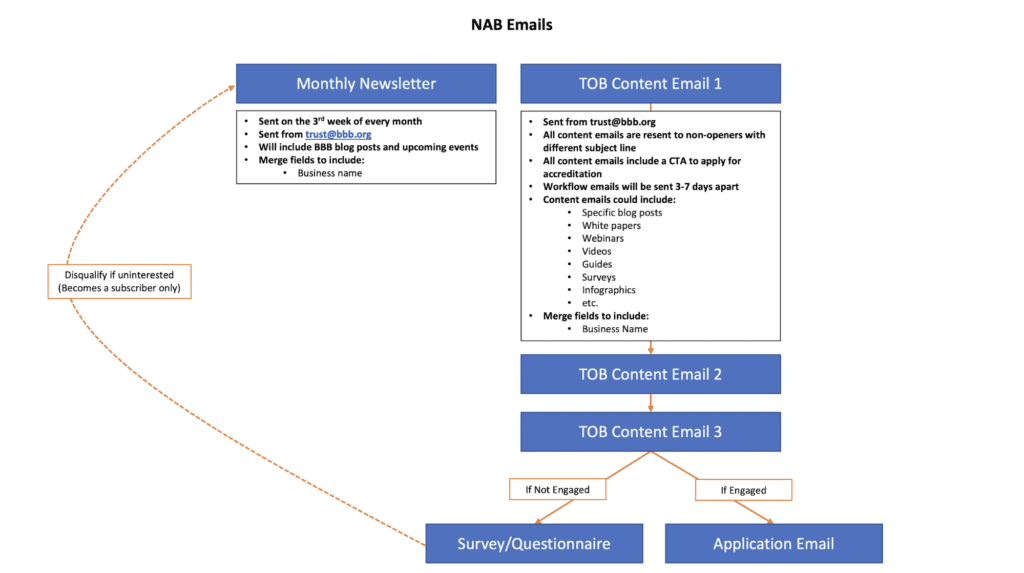
3. Develop New Content Every Month
Since BBBs aren’t allowed to index or optimize their content for SEO purposes, they typically don’t put a heavy emphasis on harnessing the power of evergreen content. Before I dive into how we leveraged content marketing to grow leads and revenue, let’s look at some key stats:
- Only 48% of B2B marketers frequently craft content based on the specific stages of the customer journey. Of the most successful content marketers, 74% do.
- Only 66% of B2B marketers frequently prioritize their audience’s needs over their sales message when creating content. Of the most successful content marketers, 88% do.
- 72% of marketers say content marketing increases engagement.
- Content marketing costs 62% less than other types of marketing.
In order to keep the content train moving along every single month, we created an editorial calendar that was relevant to the campaigns we were running, a media schedule, and the specific needs of the ABs. We also did the following:
- Adhered to the BBBNWP brand voice. Think of your brand as a person with unique characteristics. Then, write as this person. Are you formal? Casual? Humorous? Creative? Serious? Or a mixture of more than one personality? Find your distinct tone of voice and be consistent with it.
- Proper scheduling of content as I mentioned. If you plan to produce consistent content, you’ll need a content calendar so you don’t feel overwhelmed trying to figure out what to write at the last minute.
- Optimizing the right messaging for each piece of content specific to pain points ABs cared most about and just local businesses in general.
- Mixed up the content types. From videos, to memes, gifs, interactive content such as quizzes, and infographics, we made sure there was a healthy mix and leveraged analytics to help us decipher which ones performed best. We also made sure that CTAs were inputted throughout each content piece to drive people to do what we wanted them to, which was to become Accredited if they weren’t, and for retention.
- Made the content easy to read and skim. This was crucial because every piece of content we produced had headings, subheadings, listicles, etc.
Finally, we also made sure that we categorized the content into four specific buckets being sales, marketing, hiring, and finance. All four of these items were intentional because they are the top four areas where small businesses have the biggest challenges.
And to be as transparent as possible, we did end up writing a ton of content, but I picked out a few to give you an idea of everything I highlighted above:
Sales
- Simple Sales Tips Every Small Business Owner Should Consider
- How to Win More Clients for Your Roofing Business
- 10 Staggering Stats on How Reviews Can Foster Sales
Marketing
- 50 Ways to Promote Your Small Business, Part I
- 50 Ways to Promote Your Small Business, Part II
- 12 Dos and Don’ts of Email Marketing
Hiring
- [Infographic] Your Ultimate Hiring Checklist in 5 Steps
- 5 Ways to Use LinkedIn to Recruit Your Next Hire
- 10 Recruiting Strategies for Small Businesses
Finance
- How to Manage Your Small Business Finances
- 12 Small Business Tips You Haven’t Heard of Yet
- How to Budget and Increase Profits for Your Small Business
4. Apply the Growth Hacking Approach to Everything You Do
One of the practices we pushed for that continued to help us see what’s working, what isn’t and what needs improvement was growth hacking. This approach allowed us to test assumptions by putting a heavy emphasis on experimentation with the intentions of yielding positive results that would help propel BBBNWP forward. In other words, we were hyper focused on growth.
Our take on being creative with marketing initiatives wasn’t so much trying to make everything we did go viral but that whatever we did would generate leads, awareness, and contribute to an increase in revenue. That said, we were always clear on marketing dollars spent and what the return was on that investment. It was a smart and efficient way to run each campaign.

Here are some key tips to ensuring you can also growth hack your BBB to success:
- Know the buyer journey and make sure that you know exactly where the marketing injection points go to get more ABs.
- Know how to delight customers. Onboarding is one thing, but most ABs cancel because they also end up feeling that Accreditation is just a ‘nice to have’. So make sure you are leveraging your content assets to build value and get feedback for improvements.
- Stop being blinded by the bright and shining lights. It can be easy to want to do what you might think is cool or could go viral within a certain situation. Know that won’t last. Use data not just gut decisions to help steer your efforts and growth hacking will help you with that.
- Test, improve, and repeat. From headlines to ad copy and blog posts, you should be testing your messaging to see what drives targeted traffic to generating leads and revenue.
5. Data-Driven with Organizational Goals
Did you know 84% of marketers cannot measure and report on the contribution of their programs to the business, and that only 44% of CMOs say that they can measure ROI?
From the beginning of our engagement with BBBNWP until the end, data was the top driver for nearly everything we did, especially because our job was to generate awareness and leads. The only way to truly know whether or not we were successful was to ensure that we were tracking and measuring every initiative.
We also made weekly and monthly reports we could review with the management team. This also helped tremendously when it came to planning out what was going to happen quarterly and then also creating marketing plans annually. What’s important is that you do identify KPIs throughout your funnel/buyer’s journey and lifecycle stages, but that you don’t get bogged down with vanity metrics (e.g. likes, shares, etc.) that really don’t contribute directly to the livelihood of your organization.
Before we even started any execution, the strategy itself was laid out, and then we’d take the macro / big picture and slice it into something smaller, making it easier to move ahead. Here are two examples of that:
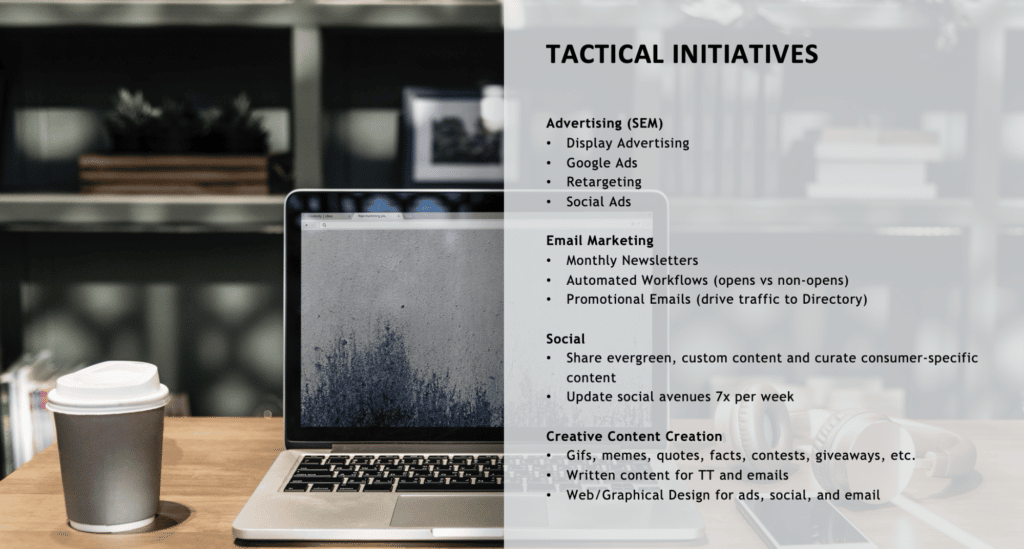
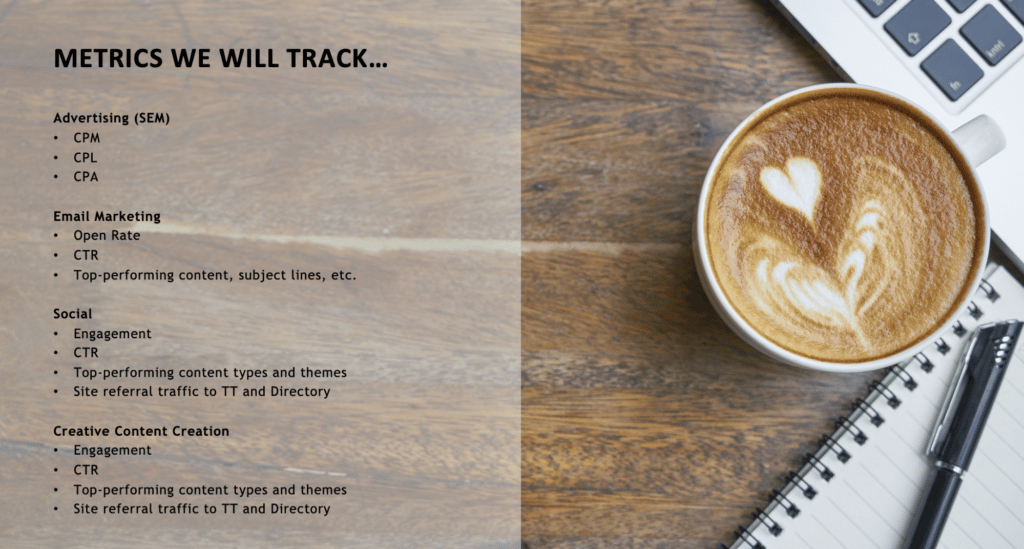
Next up, post-execution, we had a specific dashboard that we used to ensure all KPIs and metrics were reported on and we could make tweaks where needed for improvements. To give you an idea of tools you should be leveraging, we used the following:
- Ontraport. I’m sure some of you will be rolling your eyes, but it was incredibly cost-effective and did the same things tools like HubSpot could do. By going with Ontraport which was $2,400 a year, we saved a ton of money that was allocated to building awareness and generating leads that yielded revenue. We did venture down the HubSpot path and it is a product I absolutely LOVE, but it was going to cost $23,000 and up a year.
- Google Analytics and Console. Being able to see behavior flow, top-performing pages, top queries, etc. was vital to our success. We were able to base much of our campaign and editorial decisions on what we saw happening on the site and landing pages themselves.
- CrowdBabble and Native Social Platforms. This allowed us to track all social media activity such as engagement rate, impressions, organic and paid interactions, etc.
- Google Data Studio. Easy to quickly build dashboards that were digestible, we leveraged this by taking raw data and having readable graphs.
- Monday. We used Monday for project management and overseeing tasks across all departments. Such an awesome tool to plan out team sprints, tasks, and projects while also assigning people to each for accountability.
Wrapping It Up and Over to You
My goal in sharing this with you isn’t to endorse myself, but as I’ve grown through my career and worked hard to turn my passion into a full-time gig that’s scaled to a seven-figure business, I’ve craved just pure simple dropping of knowledge that helps propel people and businesses forward. The mantra I deeply believe in and is at my core as to why I do what I do is the ability to provide valuable insights and advice around digital marketing and entrepreneurship.

To sum it all up, it’s important that before any execution, you are clear with what your strategy is, then align it all to the organizational goals while always keeping BBB’s mission top of mind, which is:
BBB’s mission is to be the leader in advancing marketplace trust. We do this by:
- Setting standards for marketplace trust
- Encouraging and supporting best practices by engaging with and educating consumers and businesses
- Celebrating marketplace role models
- Calling out and addressing substandard marketplace behavior
- Creating a community of trustworthy businesses and charities
Bonus Tips and Advice
Hire a Kickass Marketing Agency
It’s okay to know that not everyone at your organization will know the ins and outs of marketing, which is why you should partner up with a reliable agency that will come in as the subject matter experts. Before you decide to hire an agency, make sure you do your part in vetting them for their knowledge — meaning a good agency partner for your marketing efforts should definitely come with strong and feasible ideas that can be implemented with a high quality of work, easily measured, and yielding strong results that show the impact their efforts have on overall business goals.
Know Your Personas
One of the most important factors of increasing ABs and keeping them on long-term lies in the fact that you know exactly who you are going after, what their pain points are, why they are Accredited, and what they need from you. Make this a priority. IMO, just pushing with BBB’s mission won’t always win every AB, but if you put their needs first and are cognizant of them, then you’ll have lifelong ABs who will refer more to you. Afterall, you’re selling to humans, so be authentic.
Take Advantage of the $10,000/mo from Google
My team and I have worked with several BBBs regarding their Google Grant account who end up just having it sit in cruise control without optimization. This is FREE money from Google. In fact, it’s $120,000 a year that Google is giving to you to advertise the BBB, especially if you are a 501(c)(3).
What we end up finding when BBB’s have turned to us is that they aren’t even spending $3,000 worth of that free money. So take advantage of it because you can drive targeted traffic to your BBB site, landing pages, blogs, webinars, scam content, etc. You can even drive targeted traffic to AB profiles which is a value-driven approach.
Disclosure: Please note that some of the links above are affiliate links. I only recommend products and services that I use and stand behind, and if you decide to try them, I will earn a commission at no cost to you. Doing so helps me run this blog and provide free content for you, my readers.
